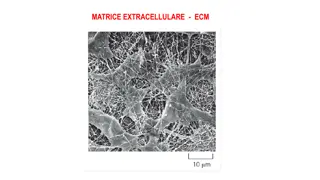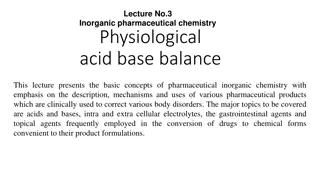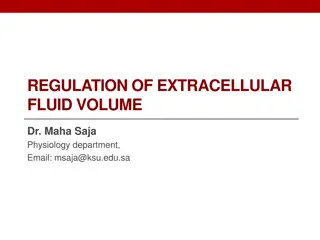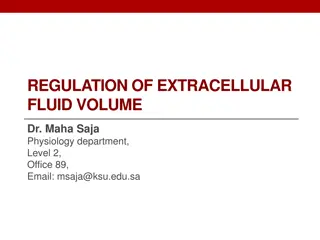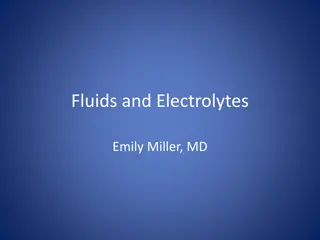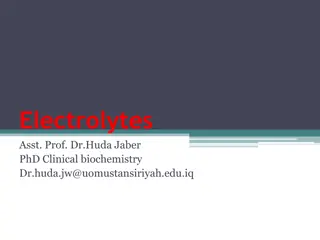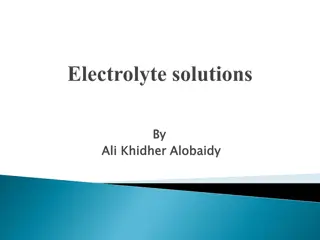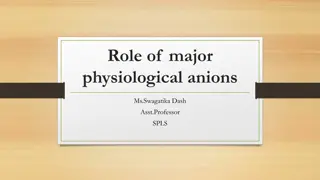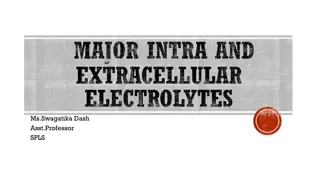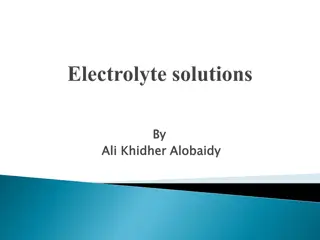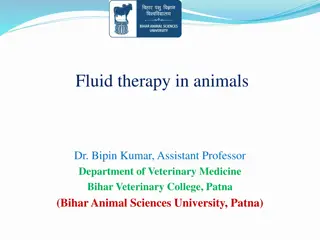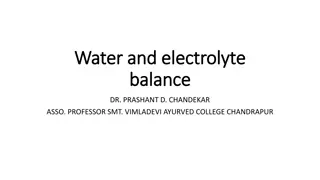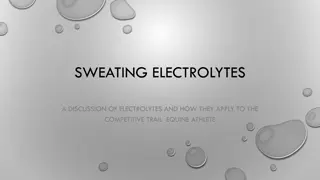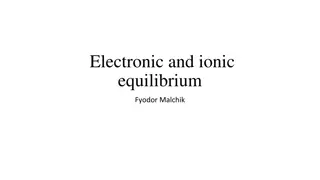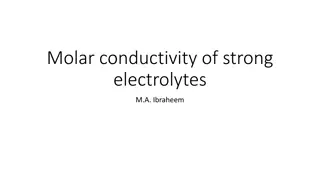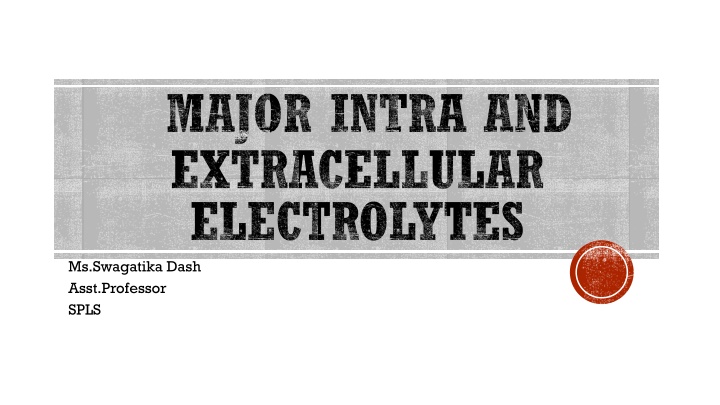
Understanding Electrolyte Balance in the Human Body
Learn about major intra and extracellular electrolytes and their concentrations in different body fluid compartments. Explore the importance of electrolytes like sodium, potassium, calcium, and magnesium, and understand their roles in maintaining overall health and physiological functions. Discover the significance of electrolyte replacement therapy and how it helps in restoring electrolyte balance in individuals undergoing surgery or facing prolonged illness.
Download Presentation

Please find below an Image/Link to download the presentation.
The content on the website is provided AS IS for your information and personal use only. It may not be sold, licensed, or shared on other websites without obtaining consent from the author. If you encounter any issues during the download, it is possible that the publisher has removed the file from their server.
You are allowed to download the files provided on this website for personal or commercial use, subject to the condition that they are used lawfully. All files are the property of their respective owners.
The content on the website is provided AS IS for your information and personal use only. It may not be sold, licensed, or shared on other websites without obtaining consent from the author.
E N D
Presentation Transcript
MAJOR INTRA AND EXTRACELLULAR ELECTROLYTES Ms.Swagatika Dash Asst.Professor SPLS
DEFINITION There are various inorganic and organic compounds present in the body fluids and the concentration of these, in various compartments, is balanced in such a way that the body cells and tissue always have the same environment. Generally in the body, the electrolyte concentration is maintained, but if a person undergoes surgery or remain ill for a long time, the body cannot maintain electrolyte balance, this is done by external administration, which is known as replacement therapy. In this type of therapy, various combinations of products such as electrolytes, acid and bases, carbohydrates, proteins, amino acids and blood products are given to the patients as per their need.
The electrolyte concentration of body fluids differ in various fluid compartments. The various body fluid compartments are- (a) Intracellular fluid- The fluid present inside the cell, e.g. cytoplasm (45-50% body weight & 30litre volume) (b) Interstitial fluid- The fluid present between the cells (12-15% body weight & 10 litre volume) (c) Plasma (vascular fluid) - The fluid present within the blood vascular system. (4-5% body weight & 3-5 litre volume) The 2nd& 3rdcategory are termed as Extracellular fluid. The body fluids are having various inorganic ions which are either anion or cation in nature. Examples of anionic electrolytes include HCO3 (bicarbonate), Cl (chloride), SO4---(sulphate) and HPO42 (phosphate) and cationic electrolytes include sodium, potassium, calcium and magnesium etc.
CONCENTRATION OF IMPORTANT ELECTROLYTES- Ions Extracellular electrolytes concentration(mEq/ L) Intracellular electrolytes concentration(mEq/ L) Plasma(range) (mEq/L) sodium (cation) potassium(cation) calcium(cation) magnesium(cation) 142 4 2.4 1.2 10 140 0.0001 58 135-145 4.5-5.5 2.1-2.6 1.5-3.0 chloride(anion) sulphate(anion) bicarbonate(anion) 103 1 28 4 2 10 98-105 0.3-1.5 25-31 phosphate(anion) 4 75 1.2-3.0
ROLE OF MAJOR PHYSIOLOGICAL CATIONS SODIUM Sodium is the most abundant extracellular ion. Daily requirements is about 3-5g for a normal adult. The good food sources for sodium are table salt, milk, baking powder, meat and vegetables. Normally kidney excretes the excess of the sodium and regulates the sodium content in the body. The sodium from the glomerular filtrate is reabsorbed which is under the hormonal control. Prostaglandin is also said to be responsible for the reabsorption of sodium. Functions- (1) The main component of ECF is sodium ion which is associated with chloride and bicarbonate in regulating acid-base equilibrium. (2) It helps in the maintenance of osmotic pressure of various body fluids and protect the body against excessive fluid loss. (3) It plays important role in preserving normal elasticity of muscle and permeability of cell. (4) It plays an imp role in transmission of nerve impulse.
Conditions under which there is low serum sodium level (hyponaturemia) can be summarised as follows- 1. Loss due to excessive urination in case of diabetes inspidus . 2. Excessive sodium excretion in metabolic acidosis . 3. Diarrhoea and vomiting 4. In Addison s disease in which there is decreased excretion of hormone aldosterone which is antidiuretic in nature. Conditions under which there are high serum sodium level (hypernaturemia) can be summarised as follows- 1. Severe dehydration (It results more water loss than normal electrolyte increasing concentration of sodium to water in blood) 2. Hyper adrenalism (cushing syndrome)(it involves an excess amount of cortisol that may devlop as a result of tumor,genetic condition or as a side effects of certain medication and patients may experience weight gain,thinning skin and excessive sweating. 3. Certain types of brain damage and 4. Excessive treatment with sodium salts Signs of hyponaturemia include (a) Weakness (b) dizziness (c) headache (d) hypotension (e) hypotension (f) tachycardia and shock Signs of hypernaturemia include (a) Thrist (b) fatigue (c) restlessness (d) coma
POTASSIUM Potassium is the most abundant cation in intracellular fluid. The daily requirement is about 1.5-4.5g. The good sources of potassium in food are milk, certain vegetables, meat and whole grains. Functions- (1) Contraction of muscles, especially cardiac muscle (2) Transmission of nerve impulse (3) Maintaining the electrolyte balance of various body fluids (4) Acid-base balance, osmotic pressure, water retention (5) Regulate pH by exchange against hydrogen ions
Elevated serum potassium levels (Hyperkalemia) occurs in patients with (a) Renal failure (b) Advanced dehydration or shock (c) In Addison s disease, where adrenal gland not produce sufficient amounts of hormone, which elevates the serum potassium level. Low serum potassium levels (Hypokalemia) occurs in flowing conditions (a) Malnutrition, gastrointestinal loses in diarrhoea. (b) Use of diuretics such as acetazolamide and chlorthiazide increase the excretion of potassium in urine. (c) In case of heart disease, the potassium content of myocardium is depleted. (d) Illness in which the treatment which includes i.v administration of solutions not containing potassium for a longer period of time. Signs of hyperkalemia includes (a) bradycardia, (b) poor heart sound, (c) cardiac arrest. Signs of hypokalemia includes (a) anxiety (b) abdominal cramping (c) diarrhoea (d) weakness (e) burning sensation
CALCIUM The total calcium content in body is about 22g per kg body and daily requirement is about 0.8 g. Most of the calcium is found in bones and remaining is largely found in extracellular fluid. The main dietary sources of calcium include milk, cheese, green vegetables, eggs and some fish. Calcium plays a vital role in the functioning of nerves and muscles. It also gets involved in coagulation of blood. Low calcium level causes tetanic spasms or convulsions (sudden contraction of muscle) High calcium level causes disturbances in cardiac functions.
MAGNESIUM Magnesium is the second most intracellular electrolyte. The daily requirement is about 350mg. Good food source for magnesium are various nuts, soyabeans, whole grains and sea foods. Functions- (a) It activates enzymes which are involved in carbohydrates and protein metabolism. (b) It is also important in neural transmission, neuromuscular activity, and myocardial function. Signs of hypomagnesemia includes weakness, tetany, convulsion, confusion, anorexia (threatening for eating more) nausea (urge to vomiting) and irregular heartbeat. Signs of hypermagnesemia includes drowsiness, hypotension, and cardiac arrest.

